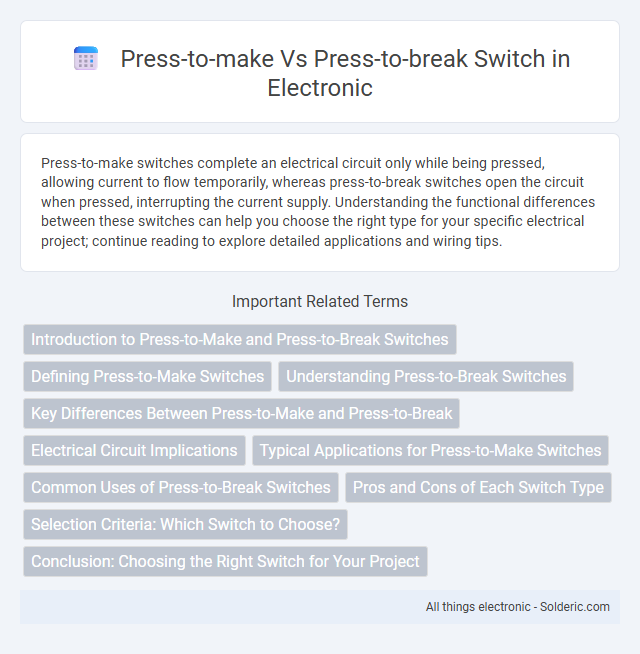Press-to-make switches complete an electrical circuit only while being pressed, allowing current to flow temporarily, whereas press-to-break switches open the circuit when pressed, interrupting the current supply. Understanding the functional differences between these switches can help you choose the right type for your specific electrical project; continue reading to explore detailed applications and wiring tips.
Comparison Table
| Feature | Press-to-Make Switch | Press-to-Break Switch |
|---|---|---|
| Function | Closes circuit when pressed | Opens circuit when pressed |
| Normal State | Open (circuit off) | Closed (circuit on) |
| Common Use | Momentary activation (e.g., doorbells) | Emergency stop or interrupt circuits |
| Contact Behavior | Completes electrical path on press | Breaks electrical path on press |
| Symbol | Normally Open (NO) | Normally Closed (NC) |
| Application Example | Keyboards, push buttons | Safety switches, kill switches |
Introduction to Press-to-Make and Press-to-Break Switches
Press-to-make switches complete an electrical circuit when pressed, allowing current to flow only while the button is held down. Press-to-break switches, conversely, disrupt the circuit upon being pressed, cutting off electrical flow during the button's activation. These switch types are fundamental in controlling devices, offering distinct functions for momentary and interruptive actions.
Defining Press-to-Make Switches
Press-to-make switches are designed to complete an electrical circuit when you press and hold the button, allowing current to flow only during the actuation. These momentary switches return to their original open state upon release, ensuring temporary connectivity ideal for applications requiring brief activation. Understanding press-to-make functionality helps differentiate it from press-to-break switches, which interrupt the circuit when pressed.
Understanding Press-to-Break Switches
Press-to-break switches are normally closed devices that open a circuit when pressed, interrupting the electrical flow. They are commonly used in safety mechanisms and emergency stop buttons to immediately halt operations by breaking the circuit. The ability to break the circuit under pressure distinguishes press-to-break switches from press-to-make switches, which close the circuit when pressed.
Key Differences Between Press-to-Make and Press-to-Break
Press-to-make switches complete an electrical circuit only when pressed, allowing current to flow temporarily, whereas press-to-break switches interrupt the circuit upon being pressed, stopping the current flow. The primary difference lies in their default states: press-to-make is normally open, and press-to-break is normally closed. Understanding these distinctions ensures you select the correct switch type for your desired control application.
Electrical Circuit Implications
Press-to-make switches complete an electrical circuit when pressed, allowing current to flow only during the actuation, making them ideal for momentary signals or triggering functions. Press-to-break switches interrupt the circuit when pressed, stopping current flow to deactivate a device or function temporarily. Your choice between these types impacts circuit behavior, influencing safety, control precision, and device response depending on whether continuous or broken contact is required.
Typical Applications for Press-to-Make Switches
Press-to-make switches are commonly used in applications requiring momentary electrical connections, such as doorbells, computer keyboards, and control panels for machinery. These switches complete a circuit only while being pressed, making them ideal for triggering short-duration signals or actions. Their reliability and simplicity make them suitable for consumer electronics, automotive controls, and handheld devices.
Common Uses of Press-to-Break Switches
Press-to-break switches are commonly used in emergency stop buttons, safety interlocks, and alarm systems where breaking the circuit immediately is crucial for safety. These switches interrupt the electrical flow to halt machinery, protect users, or trigger alerts. They are often found in industrial equipment, household appliances, and medical devices requiring rapid disconnection.
Pros and Cons of Each Switch Type
Press-to-make switches provide reliable circuit closure when pressed, offering rapid and consistent electrical contact ideal for applications requiring momentary activation, but they may suffer from wear due to constant mechanical action. Press-to-break switches excel in interrupting current flow, ensuring safety by easily cutting off power, though they can be less intuitive to use and may experience contact oxidation over time. Both switch types balance durability and functionality, making selection dependent on whether momentary connection or disconnection aligns better with specific operational needs.
Selection Criteria: Which Switch to Choose?
Press-to-make switches are ideal for applications requiring momentary activation, providing a connection only while pressed, making them suitable for tasks like doorbells or reset buttons. Press-to-break switches are chosen when the circuit needs to be normally closed and opened upon pressing, which is essential for safety interlocks and emergency stop functions. Your choice depends on whether you need the circuit to be normally open or normally closed during operation.
Conclusion: Choosing the Right Switch for Your Project
Selecting the right switch for your project hinges on understanding the functional differences between press-to-make and press-to-break switches. Press-to-make switches complete a circuit only while pressed, ideal for momentary actions like doorbells or keyboards, whereas press-to-break switches interrupt a circuit when pressed, suitable for safety or fail-safe applications. Your choice should align with the intended control logic and operational requirements to ensure reliable and efficient performance.
press-to-make vs press-to-break switch Infographic

 solderic.com
solderic.com